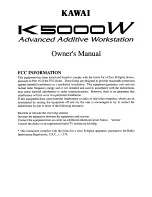
ML4000
Service Manual
13
Earthing
The connection to earth (ground) in an audio system is important for two reasons:
1.
SAFETY
- To protect the operator from high voltage shock, and
2.
AUDIO PERFORMANCE
- To minimise the effect of earth (ground) loops
which result in audible hum and buzz, and to shield the audio signals from interference.
For safety it is important that all equipment earths are connected to mains earth so that
exposed metal parts are prevented from carrying high voltage which can injure or even
kill the operator. It is recommended that the engineer check the continuity of the safety
earth from all points in the system including microphone bodies, guitar strings,
connector cases, equipment panels and so on.
The same earth is also used to shield audio cables from external interference such as
the hum fields associated with power transformers, lighting dimmer buzz, and computer
radiation. Problems arise when the signal sees more than one path to mains earth. An
earth loop results causing current to flow between the different earth paths. This
condition is usually detected as a mains frequency audible hum or buzz.
To ensure safe and trouble-free operation we recommend the following:
Use a clean mains outlet for the audio system
.
Keep the audio
equipment mains feed separate from that powering ‘dirty’ equipment such as air
conditioning and lighting systems, motors and vending machines.
Use star point earthing
.
It is best to install a ‘star point’ system where the
individual earths to the equipment racks and equipment areas are separately run from a
solid central reference earth point.
Have your mains system checked by a qualified electrician
.
If the
supply earthing is solid to start with you are less likely to experience problems.
Do not remove the earth connection from the console mains plug
.
The console chassis is connected to mains earth through the power cable to ensure
your safety. Audio 0V is connected to the console chassis internally. If problems are
encountered with earth loops operate the audio ‘ground lift’ switch on the power supply
or connected equipment, or disconnect the cable screens at one end, usually at the
destination.
Avoid induced interference
.
To prevent interference pickup keep audio cables
away from mains power units, cables and distribution boards, motors, lighting and
computer cables and equipment, and any other heavy duty electrical equipment. Where
this cannot be avoided cross the audio and ‘dirty’ equipment cables at right angles to
minimise interference.
Use low impedance sources
such as microphones and line level equipment
rated at 200 ohms or less to reduce susceptibility to interference. The console outputs
are designed to operate at very low impedance to minimise interference problems.
Use balanced connections where possible
as these provide further
immunity by cancelling out interference that may be picked up on long cable runs. To
connect an unbalanced source to a balanced console input, link the cold input (XLR pin
3 or jack ring) to 0V earth (XLR pin 1 or jack sleeve) at the console. To connect a
balanced console output to an unbalanced destination, link the cold output to 0V earth at
the console.
Use good quality cables and connectors
and check for correct wiring and
reliable solder joints. Allow sufficient cable loop to prevent damage through stretching.
Summary of Contents for ML4000
Page 1: ...SERVICE MANUAL Publication AP4316 Dual Function Live Sound Console ...
Page 14: ...14 ML4000 Service Manual Audio Connector Types and Wiring ...
Page 28: ......
Page 29: ......
Page 30: ......
Page 31: ......
Page 32: ......
Page 33: ......
Page 34: ......
Page 35: ......
Page 36: ......
Page 37: ......
Page 38: ......
Page 39: ......
Page 40: ......
Page 41: ......
Page 42: ......
Page 43: ......
Page 44: ......
Page 45: ......
Page 46: ......
Page 47: ......
Page 48: ......
Page 49: ......
Page 50: ......
Page 51: ......
Page 52: ......
Page 53: ......
Page 54: ......
Page 55: ......
Page 56: ......
Page 57: ......
Page 58: ......
Page 59: ......
Page 60: ......
Page 61: ......
Page 62: ......
Page 63: ......
Page 64: ......
Page 65: ......
Page 66: ......
Page 67: ......
Page 68: ......
Page 69: ......
Page 70: ......
Page 71: ......
Page 72: ......
Page 73: ......
Page 74: ......
Page 75: ......
Page 76: ......
Page 77: ......
Page 78: ......
Page 79: ......
Page 80: ......
Page 81: ......
Page 82: ......
Page 83: ......
Page 84: ......
Page 85: ......
Page 86: ......
Page 87: ......
Page 88: ......
Page 89: ......
Page 90: ......
Page 91: ......














































